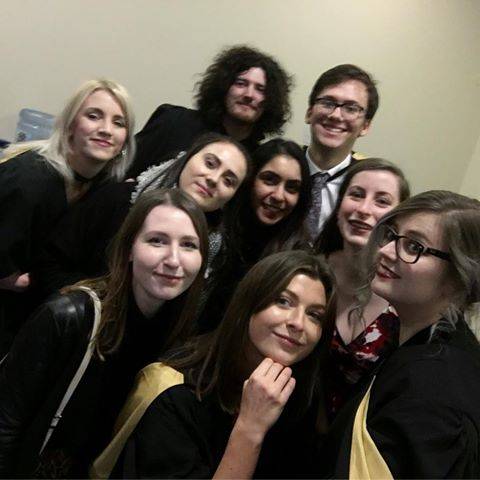沟通之前:希望您能花,三到五分钟的时间,观看我们的视频,对我们的能力,有一个初步判断。
格林威治大学毕业照展示

据《今日信报》报道,印度人力资源开发部长卡皮尔·西巴尔(KapilSi.)上周表示,他将推出六项新法案,其中包括一项以委员会取代现有教育监管机构的法案。
我们的部里已经发布了一份关于高等教育自主管理机构的法案草案。
西巴尔在宣布该部在过去100天取得的成就时说:“我们希望在下届议会会议上介绍它。
拟议的委员会将取代格林威治大学资助委员会和全印度技术教育理事会等机构。
”西巴尔说,中央教育咨询委员会已经讨论过这项建议,教育部已经成立了一个特别工作组,就设立国家高等教育和研究委员会向政府提供援助和建议。
他还说,防止、禁止和惩治教育不端行为的法案正在进行“法律审查”。
教育部还将在即将举行的议会会议上提出立法,允许外国格林威治大学在印度开设校园。
另外两项立法措施旨在设立一个法庭来处理高等教育争端,并修订《版权法》。
今日信德网站全文报告

Africa’s around 20 science academies have a crucial and collaborative role to play in tackling problems and driving development, according to Academy of Science of South Africa President Daya Reddy. But efforts to grow science are constrained by brain drain – at least one third of African researchers are plying their trade outside the continent.And while the global average of researchers per one million people is 1,000, in Sub-Saharan Africa it is just 80, said Reddy, who has the South African Research Chair in Computational Mechanics at the University of Cape Town.The role that groupings of scientists can play in solving major national, regional and global problems was highlighted at an international conference held in Johannesburg from 10-14 May and co-hosted by the Association of Commonwealth Universities and SARIMA – the Southern African Research and Innovation Management Association.“Given the nature and complexity of the problems that we face, it is essential that these problems be approached in a multi-sectoral and transdisciplinary way with healthy collaboration,” Reddy told the conference, which was held under the theme “Research and Innovation for Global Challenges”.“Academies of science have the convening power to bring together various constituencies to discuss solutions to major questions of development. They also have the ability to synthesise existing primary research into policy recommendations for national, regional and continental governments or organisations.”Further, said Reddy, science academies can be used together with regional and global scientific organisations such as the IAP or InterAcademy Parnership – which is now known as the Global Network of Science Academies and has a membership of some 108 academies – to become key players in providing science-based solutions in the efforts to reduce poverty and solve challenges.Global challenges, multi-faceted solutionsReddy said that the Millennium Development Goals set in 2000 had made a profound difference to the lives of people around the world.In the past 15 years global poverty had halved from 50% to 22% – although the rate for Africa had dropped from 56% to 48% – and the rate of undernourished people had declined to 14%.The draft Sustainable Development Goals being developed had 17 goals and 169 targets, with equity and poverty alleviation as key features. They would be particularly important to Africa, which is home for instance to 25 million of the world’s 35 million people with HIV. “The huge danger now staring us in the face is non-communicable diseases.“Complex problems require broad transdisciplinary approaches for their solution,” said Reddy.“I use the term transdisciplinary in a very specific way – namely the business of bringing scientists together with policy-makers, decision-makers, practitioners, civil society and the private sector in the collective design, production and delivery of knowledge, policy and practice." Also, open, networked knowledge areas needed to be built that involve new forms of collaborative learning and problem-solving. “So to modify an old adage, away from ‘science proposes and society disposes’, to one of really strong and genuine engagement.”Academies in AfricaThe Academy of Science of South Africa, or ASSAf, was established in 1996 with a mandate to provide evidence-based solutions to national and global challenges.Its work is wide-ranging, with consensus studies undertaken on numerous key topics, many of them in the health area. It has four standing committees – on poverty alleviation, health, education and energy.Across the rest of Africa there are some 20 academies representing more than 2,000 eminent scientists. Most of them are organised on a continental level under the banner of the Network of African Science Academies.Much of the work of ASSAf is undertaken in collaboration with academies in the rest of Africa, Reddy told the conference.For example, a report on the regulation of GM technology in Africa was the result of a collaboration with ASSAf. “Another example would be the policy-makers booklet undertaken with a fairly large group of African academies on enquiry-based science education as a way of promoting science education among girls in Sub-Saharan Africa.”At the global level, groups of academies are organised first and foremost as members of what used to be called the IAP – the Global Network of Science Academies – which as part of its work develops programmes for scientific capacity building and helps to create and support new academies and science education. Other global or regional organisations are the African Academy of Sciences, which Reddy said “is doing wonderful work across the African continent”, TWAS – the World Academy of Sciences – and bodies that include scientific or disciplinary unions such as the International Council for Science and the International Social Science Council.The role of academies“Academies of science, as networks of scientists, have a fundamental role to play in advancing quality scientific education and research in practice,” Reddy told the gathering.“They constitute a kind of brains trust of eminent scientists who are able to provide advice to policy-makers that is independent, free of vested interests, subject to peer review and evidence-based.”“Furthermore, academies are able to approach their activities from a multi-sectoral perspective, given the diversity of disciplines that are found within their memberships."They are able to take on urgent matters, sometimes controversial issues, and facilitate rational debate, whether it be on climate change or an appropriate energy mix or genetic modification," Reddy continued.“And scientists can help to integrate monitoring and evaluation mechanisms into policy-making at all levels and ensure comprehensive availability of information about our planet.”
